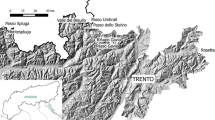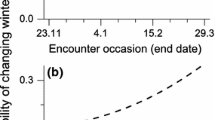Summary
This study examines the relative importance of habitat and season in determining size and composition of foraging flocks of European Starlings (Sturnus vulgaris). We hypothesized that if season was the principal determinant of flock size, variation across seasons (within habitat) would be greater than variation across habitats (within season). The calendar year was divided into 6 seasons corresponding to major stages in the annual cycle of starlings. After measuring the availibility of 15 foraging habitats occurring within the study area, we drove a 184 km route weekly (over a 17 month period) to census starling flock size, species composition, habitat use, and activity.
Although flock size was influenced by both season and habitat, it varied relatively less within seasons (across habitats). Only five of nine seasons showed significant habitat effects, and two (of the five) were significant mainly because of large aggregations in habitats with unusually abundant food (e.g. feedlots, cornfields). In contrast, eight of nine habitats showed significant seasonal effects. The only exception (hay) was little used (<1% of all birds observed). For starlings the activities associated with seasonal events of the annual cycle were a major influence on patterns of social foraging. Habitat factors were less important because of constraints imposed by seasonal factors, but under some conditions (e.g. drought, clumped food supply) they became dominant.
Similar content being viewed by others
References
Berthold P (1976) The control and significance of animal and vegetable nutrition in omnivorous song birds. Ardea 64:140–154
Caccamise DF, Lyon LA, Fischl J (1983) Seasonal patterns in roosting associations composed of Starlings and Common Grackles. Condor 84:474–481
Caraco T (1979a) Time budgeting and group size: a theory. Ecology 60:611–617
Caraco T (1979b) Time budgeting and group size: a test of theory. Ecology 60:618–627
Cody ML (1971) Finch flocks in the Mohave Desert. Theor Popul Biol 2:142–158
Davis GJ (1970) Seasonal changes in flocking behavior of Starlings as correlated with gonadal development. Wilson Bull 82:391–399
Dolbeer RA, Woronecki PP, Stickley AR, White SB (1978) Agricultural impact of a winter population of blackbirds and Starlings. Wilson Bull 90:31–44
Dunnet GM (1955) The breeding of the StarlingSturnusvulgaris in relation to its food supply. Ibis 97:619–662
Dunnet GM (1956) The autumn and winter mortality of StarlingsSturnus vulgaris, in relation to their food supply. Ibis 98:220–230
Fischl J (1983) The ecology of aggregative behavior in the European Starling: 1. Relationships between habitat utilization and flock characteristics, 2. Patterns in roosting behavior in relation to diet. MS Thesis Rutgers University, New Brunswick, NJ, 87 pp
Hamilton HD (1971) Geometry for the selfish herd. J Theor Biol 31:295–311
Johnson RJ, Caslick JW (1982) Habitat relationships of roosting and flocking Red-winged Blackbirds. J Wildl Manage 46:1071–1077
Kalmback ER, Gabrielson IN (1921) Economic value of the starling in the United States. U.S.D.A. Bull 868, 66 pp
Kessel B (1957) A study of the breeding biology of the European Starling (Sturnus vulgaris dL.) in North America. Am Mid Nat 58:257–331
Knopf FL, Knopf BA (1983) Flocking pattern of foraging American Crows in Oklahoma. Wilson Bull 95:153–155
Krebs JR (1974) Colonial nesting and social feeding as strategies for exploiting food resources in the Great Blue Heron (Ardea herodias). Behav 51:99–134
Krebs JR, MacRoberts MH, Cullen JM (1972) Flocking and feeding in the Great Tit,Parus major — an experimental study. Ibis 114:507–530
Lazarus J (1979) The early warning function of flocking in birds: an experimental study with captive Quelea. An Behav 27:855–865
Lorvari S (1976) Population trends and seasonal flock size variation of Alpine Choughs, Choughs and Ravens in the Abruzzo National Park, Italy. Le Gerfaut 66:207–219
Lindsey AA (1939) Food of the starling in central New York state. Wilson Bull 51:176–182
Lyon LA, Caccamise DF (1981) Habitat selection by roosting blackbirds and Starlings: management implications. J Wildl Manage 45:435–443
Morse DH (1971) The insectivorous bird as an adaptive strategy. Ann Rev Ecol Sys 2:177–200
National Oceanic and Atmospheric Administration, National Climatic Center (1979) Climatological data: New Jersey Annual Summary, vol 84, no 13
National Oceanic and Atmospheric Administration, National Climatic Center (1980) Climatological data: New Jersey. Annual Summary vol 85, no 13
National Oceanic and Atmospheric Administration, National Climatic Center (1981) Climatological data: New Jersey. Annual Summary vol 86, no 13
O'Neill RV (1969) Indirect estimation of energy fluxes in animal food webs. J Theor Biol 22:284–290
Pielou EC (1977) Mathematical ecology. Wiley, New York, pp 291–311
Powell GVN (1974) Experimental analysis of the social value of flocking by starlings (Sturnus vulgaris) in relation to predation and foraging. An Behav 22:501–505
Pulliam HR (1973) On the advantages of flocking. J Theor Biol 38:419–422
Pulliam HR (1982) The scanning behavior of juncos: a game-theoretical approach. J Theor Biol 95:89–103
Russel DN (1971) Food habits of the starling in eastern Texas. Condor 73:369–372
Schluter D (1984) Feeding correlates of breeding and social organization in two Galapagos finches. Auk 101:59–68
Smith JNM, Grant PR, Grant BR, Abbott IJ, Abbott LK (1978) Seasonal variation in feeding habits of Darwin's ground finches. Ecology 59:1139–1150
Steel RGD, Torrie JA (1980) Principles and procedures of statistics. A biometrical approach. McGraw-Hill, New York, pp 172–194
Swenson JE (1980) Seasonal changes in habitat use and flock size by Black-billed Magpies along the lower Yellowstone River, Montana. Prairie Nat 12:105–109
Thompson WA, Vertinsky I, Krebs JR (1974) The survival value of flocking in birds: a simulation model. J Anim Ecol 43:785–820
Treisman M (1975) Predation and the evolution of gregariousness. II. An economic model for the predator-prey interaction. An Behav 23:801–825
USDA, Soil Conservation Service (1979) New Jersey soil erosion, sediment, and animal waste study. Unpublished study
USDA, Soil Conservation Service (1982) National Resource Inventory. Unpublished study
Vanderploeg HA, Scavia D (1979) Two electivity indices for feeding with special reference to zooplankton grazing. J Fish Res Board Can 36:362–365
Williamson P, Gray L (1975) Foraging behavior of the Starling (Sturnus vulgaris) in Maryland. Condor 77:84–89
Author information
Authors and Affiliations
Rights and permissions
About this article
Cite this article
Fischl, J., Caccamise, D.F. Influence of habitat and season on foraging flock composition in the European Starling (Sturnus vulgaris). Oecologia 67, 532–539 (1985). https://doi.org/10.1007/BF00790025
Received:
Issue Date:
DOI: https://doi.org/10.1007/BF00790025




